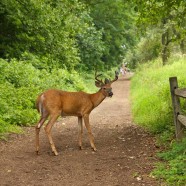Close-up Deer
This picture by RTPI Affiliate Sean Graesser shows us what we do not want to see. This White-tailed Deer should have a lot more fear of humans, and their overpopulation in many areas is a leading factor in the continuing degradation of our forest understory habitat, especially in consideration of nesting bird species. Apples certainly are a tasty treat, but this is a wild animal, not a petting zoo!
Read MoreWhite-tailed Deer
Wherever you go you can find White-tailed Deer. Hiking through a salt marsh with a rising tide? You got it. This deer was in the Stewart B. McKinney National Wildlife Refuge. That is Long Beach in Stratford, Connecticut in the background with the even further horizon being Long Island, New York. It looks like a rather quick swim, doesn’t it? Yes, White-tailed Deer can swim, even to some islands! But I do not think they would be able to make it to Long Island from here… Scott Kruitbosch Conservation & Outreach Coordinator
Read MoreWhite-tailed Deer name origin
Let’s take a few moments to discuss the name origin of the White-tailed Deer (Odocoileus virginianus) and how it came to be known…well, OK then. Never mind. I think we cracked the case on that mystery. Maybe next time we can examine why the Yellow Warbler has such a colorful name. Scott Kruitbosch Conservation & Outreach Coordinator
Read MoreAntler Asymmetry
White-tailed Deer (Odocoileus virginianus) are a common sight throughout the Chautauqua-Allegheny region. These large mammals are often seen within the forests, fields and backyards that make up the area and all look relatively similar, having a brown and white body, big black eyes, black snouts and that characteristic white tail. This widespread ungulate often goes overlooked due to our familiarity with its presence and its rather ordinary look throughout most of the year. However, as autumn approaches, deer become much more interesting to some as males adorned with their large, bony...
Read More







